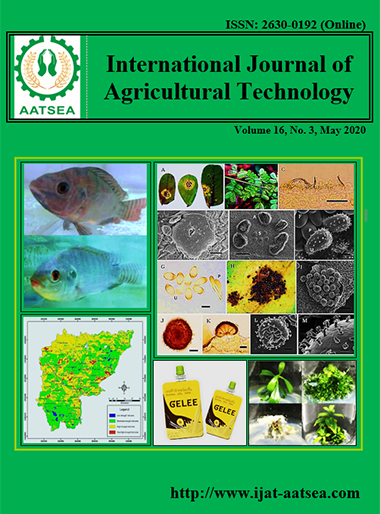The utilization of leguminous Gliricidia sepium as natural fertilizers to improve soil fertility
Main Article Content
Abstract
Soil degradation is one of the most important problem to be solved for sustainable agriculture. To improve soil from repetitive land use, the leguminous plant Gliricidia sepium was evaluated as natural fertilizer supplementation. The experiment was carried out in pot trial. Green leaf manure and intercropping gave positive effects on the growth of sweet corn. The pH, organic matter content as well as nitrogen, potassium, phosphorous and calcium content of the soil amended with the leaves of G. sepium increased. Green leaf manure at 5 and 10 percent supplementation gave the highest plant growth at 4 weeks after transplantation. However, 10 and 20 percent supplementation ratio gave the highest plant development at 8 weeks after transplantation. The chemical properties and nutritional status of the soil increased when mixed with green manure or intercropped with G. sepium.
Article Details

This work is licensed under a Creative Commons Attribution-NonCommercial-NoDerivatives 4.0 International License.
References
Abdul, R. B. and Zaharah, A. R. (2006). Gliricidia (Gliricidia sepium) green manures as a potential source of N for maize production in the tropics. Optimizing nitrogen management in food and energy production and environmental protection. Proceedings of the 2nd International Nitrogen Conference on Science and Policy TheScientific World, 1:90-95.
Beedy, T. L., Snapp, S. S., Akinnifesi, F. K. and Sileshi, G. W. (2010). Impact of Gliricidia sepium intercropping on soil organic matter fractions in a maize-based cropping system. Agriculture, Ecosystems and Environment, 138:139-146.
Bender, R. R., Haegele, J. W., Ruffo, M. L. and Below, F. E. (2013). Modern corn hybrids’ nutrient uptake patterns. Better Crops, 97:7-10.
Carter, M. R. and Gregorich, E. G. (2008). Soil sampling and methods of analysis. 2nd Edition, Canadian Society of Soil Science, Taylor & Francis Group, LLC, Boca Raton.
Cubillos-Hinojosa1, J. G., Milian-Mindiola1, P. E. and Hernández-Mulford, J. L. (2011). Biological nitrogen fixation by Rhizobium sp. native gliricidia (Gliricidia sepium [Jacq.] Kunth ex Walp.) under greenhouse conditions. Agronomía Colombiana, 29:465-472.
Duchene, O., Vian, J. F. and Celette, F. (2017). Intercropping with legume for agroecological cropping systems: Complementarity and facilitation processes and the importance of soil microorganisms. A review. Agriculture, Ecosystems & Environment, 240:148-161.
Food and Agriculture Organization of United Nations (FAO) (2015). The importance of soil organic matter. FAO soils bulletin 80.
Lal, R. (2007). Anthropogenic influences on world soils and implications to global food security. Advances in Agronomy, 93:69-93.
Lavin, M., Mathew, S. and Hughes, C. (1991). Chloroplast DNA variation in Gliricidia sepium (Leguminosea): interspecific phylogeny and togogeny. American Journal of Botanica, 78:1576-158.
Maitra, S., Zaman, A., Kumar Mandal., T. and Bharati Palai, J. (2018). Green manures in agriculture: A review. Journal of Pharmacognosy and Phytochemistry, 7:1319-1327.
Nleya, T., Chungu, C. and Kleinjan, J. (2016). Corn growth and development. iGrow Corn: Best Management Practices, pp. 5-8.
Pansak, W., Hilger, T. H., Dercon, G., Kongkaew, T. and Cadisch, G. (2008). Changes in the relationship between soil erosion and N loss pathways after establishing soil conservation systems in uplands of Northeast Thailand. Agriculture, Ecosystems and Environment, 128:167-176.
Pandey, C. B. and Rai, R. B. (2007). Nitrogen cycling in gliricidia (Gliricidia sepium) alley cropping in humid tropics. Tropical Ecology, 48:87-97.
Preston, S. (2003). Overview of Cover Crops and Green Manures. Fundamentals of Sustainable Agriculture, pp. 1-13.
Putthacharoen, S., Howeler, R. H., Jantawat, S. and Vichukit, V. (1998). Nutrient uptake and soil erosion losses in cassava and six other crops in a Psamment in eastern Thailand. Field Crops Research, 57:113-126.
Ransom, J., Endres, G. J., Berlund, D. R., Endres, G. J. and McWilliams, D. A. (2014). Corn growth and management: Quick Guide. North Dakota State University Extension Service, Fargo, ND.
Ritchie, S. W., Hanway, J. J. and Benson, G. O. (1997). How a corn plant develops. Special report No. 48. Iowa State University Press. Ames, Iowa.
Stewart, J. L., Allison, G. E. and Simons, A. J. (1996). Glicidia sepium: Genetic resources for farmers. Tropical forestry papers No.33. Oxford Forestry Institute, Department of Plant Sciences, University of Oxford. UK.
Tingting, L. V., Xiaoyua, S., Dandana, Z., Zhenshana, X. and Jianminga, G. (2008). Assessment of soil erosion risk in northern Thailand. The International Archives of the Photogrammetry, Remote Sensing and Spatial Information Sciences. Vol. XXXVII. Part B8, pp. 703-708.
Troeh, F. R. and Thompson, L. M. (2005). Soils and soil fertility. 6thEdition. Blackwell Publishing Professional, Iowa, 489.


